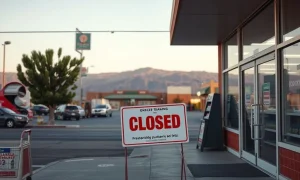The recent closure of a Starbucks location often sends ripples through a community. For many, this event is more than just a loss of a coffee shop; it signals deeper Urban Economic Challenges plaguing an embattled city. This particular closure, indeed, serves as a stark reminder of the struggles faced by urban centers across the nation. Business leaders and residents alike watch closely, understanding that such events can significantly impact local economies and community morale. What does this specific closure reveal about the broader economic landscape?
Understanding the Immediate Impact of Business Closures on Urban Economic Challenges
When a prominent business like Starbucks shuts its doors, the immediate effects are tangible. First, the city loses a source of tax revenue. Furthermore, local employment opportunities diminish. The closure also affects foot traffic, which is vital for surrounding businesses. For instance, neighboring shops and restaurants often rely on the steady stream of customers generated by anchor tenants. Consequently, their own sales may decline.
The symbolic impact is also significant. A Starbucks closure can be perceived as a vote of no confidence in the area’s economic viability. This perception can deter new investments and encourage other businesses to reconsider their presence. Therefore, the ripple effect extends beyond immediate financial losses, influencing the long-term economic outlook. Addressing these Urban Economic Challenges requires a multifaceted approach.
- Loss of Jobs: Employees face unemployment, impacting local households.
- Reduced Foot Traffic: Neighboring businesses suffer from fewer potential customers.
- Decreased Tax Revenue: Cities lose sales and property tax contributions.
- Negative Perception: The closure can signal a declining business environment.
Unpacking the Core Urban Economic Challenges Facing Cities
The closure of a single business is rarely an isolated incident. Instead, it often reflects underlying Urban Economic Challenges that have been simmering for years. Several factors contribute to these difficulties. Firstly, the rise of remote work has reduced the number of daily commuters in downtown areas. This shift directly impacts businesses that rely on office workers for their customer base. Secondly, changing consumer habits, with a preference for online shopping, continue to reshape the retail landscape. Brick-and-mortar stores face increased competition and reduced demand.
Moreover, issues such as rising crime rates and visible homelessness can deter both customers and potential investors. These social problems create an unwelcoming environment, making businesses less profitable and more challenging to operate. High operating costs, including rent and labor, further squeeze profit margins for many establishments. Ultimately, a combination of these factors creates a difficult environment for businesses to thrive, exacerbating Urban Economic Challenges.
Key Factors Contributing to Economic Downturns:
- Remote Work Trends: Fewer commuters mean less demand for urban services.
- E-commerce Growth: Online shopping diverts sales from physical stores.
- Public Safety Concerns: Crime and disorder deter customers and investment.
- High Operating Costs: Rent, wages, and utilities can make urban locations unsustainable.
- Lack of Investment: A decline in new businesses or infrastructure projects.
The Ripple Effect: How Closures Worsen Urban Economic Challenges
One business closure can trigger a domino effect throughout a local economy. When an anchor tenant like Starbucks leaves, other businesses that benefited from its presence may also struggle. For example, a sandwich shop next door might see a significant drop in lunch customers. Similarly, a bookstore across the street might lose patrons who used to combine their coffee run with browsing for books. Consequently, these smaller businesses may find it difficult to sustain operations.
Furthermore, vacant storefronts create a less vibrant streetscape. This can make an area seem less appealing to both residents and tourists. A series of empty premises can signal decline, deterring new businesses from opening. This negative cycle can deepen Urban Economic Challenges, making revitalization efforts more arduous. Cities must proactively address these interconnected issues to prevent further deterioration.
The psychological impact on remaining business owners is also noteworthy. They may feel less secure about their own future, potentially delaying expansion plans or even considering relocation. This uncertainty further hampers economic growth and job creation within the city. Therefore, the initial closure sets off a chain reaction that amplifies existing vulnerabilities in the urban economy.
Community Morale and Perception Amidst Urban Economic Challenges
Beyond the financial and commercial impacts, business closures profoundly affect community morale. Residents often view their local businesses as integral parts of their neighborhood’s identity. A familiar coffee shop, for instance, can serve as a community hub, a meeting place, or a symbol of local vibrancy. Its disappearance can lead to a sense of loss and disillusionment among citizens.
This decline in morale can manifest in several ways. People may feel less safe or proud of their city. This sentiment can lead to reduced engagement in local activities and even encourage residents to move away. Ultimately, a diminishing sense of community can make it harder to rally support for revitalization initiatives. Addressing these emotional and psychological aspects is crucial when tackling Urban Economic Challenges. A city’s perceived health directly influences its ability to attract and retain both people and capital.
Media coverage of closures also shapes public perception. Negative news can reinforce the idea of a struggling city, making it harder to attract new residents or businesses. Conversely, positive stories about resilience and revitalization can inspire hope and encourage investment. Therefore, managing public perception becomes a key component of economic recovery strategies.
Strategies for Overcoming Urban Economic Challenges and Fostering Revitalization
Cities facing significant Urban Economic Challenges must implement comprehensive strategies for revitalization. These plans often involve multiple stakeholders, including city government, local businesses, and community organizations. One critical step involves enhancing public safety. A secure environment is fundamental for attracting residents, visitors, and businesses. This includes increased police presence and community-based safety programs.
Secondly, economic development initiatives are essential. Cities can offer incentives to new businesses, such as tax breaks or grants, to encourage them to open in struggling areas. Supporting existing small businesses through training programs and access to capital is also vital. Furthermore, investing in infrastructure improvements, such as public transport and walkable streets, can make urban areas more attractive.
Engaging the community is another key component. Encouraging local residents to support businesses and participate in civic life strengthens the social fabric. Promoting cultural events and public spaces can also create a vibrant atmosphere, drawing people back to city centers. Ultimately, a holistic approach addresses both economic and social factors to build a resilient urban future.
Effective Revitalization Strategies:
- Prioritize Public Safety: Increase police visibility and implement community safety programs.
- Offer Business Incentives: Provide tax breaks, grants, or streamlined permitting for new businesses.
- Invest in Infrastructure: Improve transportation, public spaces, and digital connectivity.
- Support Small Businesses: Offer training, mentorship, and access to funding.
- Promote Community Engagement: Encourage local participation and foster a sense of belonging.
- Develop Unique Identity: Highlight local culture and unique attractions to draw visitors.
The journey to overcome Urban Economic Challenges is complex and long-term. However, through strategic planning and collaborative effort, cities can reverse trends of decline. The closure of a Starbucks, while a setback, can serve as a catalyst for renewed focus and action. It highlights the urgent need for comprehensive solutions that address the root causes of urban economic distress. Moving forward, cities must embrace innovation and resilience to build stronger, more vibrant communities for all.
Frequently Asked Questions (FAQs) About Urban Economic Challenges
Q1: What are the primary causes of urban economic decline?
Urban economic decline stems from various factors. Key causes include the shift to remote work, which reduces downtown foot traffic, and the growth of e-commerce, which impacts physical retail. Additionally, public safety concerns like rising crime rates, high operating costs for businesses, and a lack of new investment contribute significantly to these challenges.
Q2: How does a major business closure impact a city’s economy?
A major business closure, like that of a Starbucks, has several impacts. It leads to job losses and reduced tax revenue for the city. Furthermore, it decreases foot traffic for surrounding businesses, creating a ripple effect. Symbolically, it can signal economic instability, deterring new businesses and investors from entering the area.
Q3: What role does community morale play in urban revitalization?
Community morale plays a crucial role. When businesses close, residents may feel a sense of loss and disillusionment. This can reduce their engagement in local activities and even lead to out-migration. A strong, positive community spirit, however, fosters resilience and encourages collective efforts towards revitalization, making a city more attractive for living and investment.
Q4: What strategies can cities employ to combat urban economic challenges?
Cities can employ several strategies to combat Urban Economic Challenges. These include prioritizing public safety through increased police presence, offering incentives to attract new businesses, and investing in infrastructure improvements. Supporting existing small businesses and fostering strong community engagement are also vital for long-term recovery and growth.
Q5: How do changing consumer habits affect urban retail environments?
Changing consumer habits, particularly the preference for online shopping, significantly affect urban retail. This shift reduces the demand for traditional brick-and-mortar stores, leading to decreased sales and profitability. Consequently, many physical retailers struggle to compete, resulting in closures and vacant storefronts that contribute to urban economic challenges.
Q6: Is it possible for an embattled city to fully recover from economic decline?
Yes, it is possible for an embattled city to recover, but it requires sustained, multi-faceted effort. Full recovery involves addressing root causes, implementing comprehensive revitalization strategies, fostering public-private partnerships, and building community resilience. While challenging, many cities have successfully transformed their economies through strategic planning and dedicated execution.
























